KEY POINTS
- The core difference is the zodiac system: Western astrology uses the Tropical Zodiac, which is based on seasons, while Vedic astrology uses the Sidereal Zodiac, which is fixed to the constellations.
- Western astrology incorporates the modern outer planets (Uranus, Neptune, Pluto) for psychological analysis, whereas Vedic astrology focuses on the seven classical planets and the lunar nodes (Rahu and Ketu) for karmic and predictive purposes.
- Western astrology primarily uses transits and progressions for forecasting, while Vedic astrology uses the highly specific Dasha system to provide a detailed timeline of when life events are likely to occur.
For millennia, humans have looked to the heavens for answers, seeking to understand their place in the universe and the unseen forces that shape their lives. This universal quest gave rise to two of the world’s most profound and enduring systems of cosmic interpretation: Western and Vedic astrology. While both traditions draw from the same sky, their fundamental approaches to the zodiac, planetary influences, and ultimate purpose differ significantly, offering distinct paths to self-discovery. Understanding these core differences—rooted in the Tropical versus Sidereal zodiac, the inclusion of modern planets, and deeply contrasting philosophical foundations—is the essential first step for anyone seeking guidance from the stars, helping them choose the system that best aligns with their personal journey and worldview.
The Core Distinction: The Zodiac Systems
The most fundamental and impactful difference between Western and Vedic astrology lies in the zodiac they use. This single distinction causes a domino effect, altering a person’s Sun sign and the entire orientation of their birth chart.
It is the primary reason your sign in one system is often different from your sign in the other.
The Tropical Zodiac (Western Astrology)
Western astrology utilizes the Tropical Zodiac, which is intrinsically linked to the Earth’s seasons. This system fixes the starting point of the zodiac—0 degrees of Aries—to the vernal (spring) equinox in the Northern Hemisphere.
Consequently, the signs are tied to the changing seasons: Aries begins with spring, Cancer with summer, Libra with autumn, and Capricorn with winter. This approach makes the Western zodiac a symbolic framework focused on the psychological and developmental cycles experienced on Earth.
However, due to a slow wobble in the Earth’s axis known as the precession of the equinoxes, the position of the equinox drifts backward against the backdrop of the fixed stars over centuries. The Tropical zodiac moves with this precession, meaning the signs no longer align with their namesake constellations.
The Sidereal Zodiac (Vedic Astrology)
Vedic astrology, also known as Jyotish, uses the Sidereal Zodiac. The word “sidereal” means “of the stars,” and this system is anchored to the fixed positions of the constellations as they actually appear in the sky.
It accounts for the precession of the equinoxes by using a correction factor called the ayanamsa. This ensures that when Vedic astrology refers to Mars being in Aries, it means Mars is located within the observable star cluster of the Aries constellation.
Currently, the difference between the Tropical and Sidereal zodiacs is about 24 degrees. This means that if you were born in the first 24 days of a Western sign, your sign in the Vedic system will likely be the preceding one. For example, a person with a Sun in 15 degrees Aries in Western astrology would have their Sun at approximately 21 degrees Pisces in Vedic astrology.
Planetary Rulers and Their Significance
The planets used and how they are prioritized also mark a major divergence between the two systems, reflecting their historical and philosophical developments.
The Outer Planets: A Modern Western Addition
Western astrology is an evolving system that has incorporated astronomical discoveries over time. It uses the three outer, transpersonal planets discovered in the modern era: Uranus (discovered 1781), Neptune (1846), and Pluto (1930).
These planets are considered generational rulers, representing profound, slow-moving forces of societal change, spiritual evolution, and psychological transformation. In modern Western astrology, Uranus became the new ruler of Aquarius, Neptune of Pisces, and Pluto of Scorpio, supplanting their traditional rulers.
The Seven Classical Planets and Two Nodes (Vedic)
Vedic astrology traditionally adheres to the seven classical, visible celestial bodies: the Sun, Moon, Mercury, Venus, Mars, Jupiter, and Saturn. These are the planets that can be seen with the naked eye and have been observed for thousands of years.
While the outer planets are acknowledged by some modern Vedic astrologers, they are not integrated into the core predictive systems. Instead, Jyotish places immense importance on the lunar nodes—Rahu (the North Node) and Ketu (the South Node). These are not physical planets but mathematical points where the Moon’s orbit intersects the Earth’s ecliptic path. In Vedic philosophy, Rahu and Ketu are treated as powerful “shadow planets” that dictate karmic destiny, obsessions, and spiritual liberation.
The Houses: A Different Perspective
Both systems divide the sky into twelve houses, each representing a specific area of life, such as career, relationships, family, and spirituality. However, the method of calculating these houses differs, which can change the planetary placements within them.
Western astrology employs numerous house systems, with the Placidus system being the most popular. Placidus divides the houses based on time, resulting in houses of varying sizes. This can lead to complex interpretations where a single house may span multiple signs.
Vedic astrology predominantly uses the Whole Sign House system. In this straightforward approach, each of the twelve signs occupies one full house. If your ascendant (rising sign) is Leo, the entire sign of Leo constitutes your first house, the entire sign of Virgo is your second house, and so on. This creates a clean, symmetrical chart that emphasizes the power of the sign ruling each area of life.
Aspects and Yogas: How Planets Interact
The way planets influence each other is another area of significant contrast. Western astrology focuses on geometric angles, while Vedic astrology uses a system of planetary “glances” and powerful combinations.
Western Aspects: A Geometric Approach
In the Western tradition, aspects are specific angular relationships between planets, measured in degrees. The major aspects include the conjunction (0°), sextile (60°), square (90°), trine (120°), and opposition (180°).
These aspects are categorized by the quality of energy they produce. Trines and sextiles are considered “soft” or harmonious, indicating ease and talent. Squares and oppositions are “hard” or challenging, representing tension, conflict, and opportunities for growth.
Vedic Drishti and Yogas: A Planetary Gaze
Vedic astrology uses a concept called drishti, or planetary aspect, which translates to “glance.” Every planet casts a glance on the house opposite it (the 7th house from its position). However, some planets have special aspects: Mars also aspects the 4th and 8th houses from its location; Jupiter aspects the 5th and 9th; and Saturn aspects the 3rd and 10th.
Even more central to Jyotish is the concept of Yogas. Yogas are specific planetary combinations and placements that produce predictable, powerful results. There are hundreds of yogas, such as Raja Yogas (yogas of power and success) and Dhana Yogas (yogas of wealth). The presence of these yogas is a primary focus of a Vedic chart reading.
Predictive Techniques and Timing
Perhaps the most compelling feature of Vedic astrology for many is its highly specific system for predicting the timing of life events, which differs greatly from Western methods.
Transits and Progressions in Western Astrology
Western astrology primarily uses transits and progressions for forecasting. Transits analyze the ongoing movement of planets in the current sky and how they interact with your natal chart. Progressions are symbolic techniques, with the most common being Secondary Progressions, where each day after birth corresponds to one year of life.
These techniques are excellent for identifying periods of psychological development, inner shifts, and windows of opportunity or challenge.
The Vimshottari Dasha System in Vedic Astrology
Vedic astrology’s crowning predictive tool is the Dasha system. This is a unique method of mapping out major and minor planetary periods throughout a person’s life. The most widely used is the Vimshottari Dasha, a 120-year cycle based on the position of the Moon at birth.
This system provides a detailed timeline showing which planet’s energy will be most influential during specific years, months, and even days of your life. An astrologer can use the Dasha system to predict with remarkable accuracy when events related to career, marriage, health, or finances are likely to unfold.
Philosophical and Spiritual Foundations
Ultimately, the two systems are born from different worldviews. Western astrology, particularly in its modern form, is heavily influenced by Greek philosophy, humanistic psychology, and a focus on individuality and self-actualization. The chart is a map of the psyche, a tool to help a person understand their personality, unlock their potential, and navigate their life with greater self-awareness.
Vedic astrology, or “the science of light,” is an inseparable limb of ancient Vedic wisdom from India. It is deeply rooted in the philosophies of karma (the law of cause and effect), dharma (one’s righteous duty or life purpose), and reincarnation. A Vedic chart is seen as a blueprint of the soul’s karmic journey, revealing the accumulated karma from past lives that is destined to unfold in this one. A key part of a Vedic consultation often involves prescribing remedial measures, or upayas—such as wearing specific gemstones, chanting mantras, or performing charitable acts—to mitigate negative karma and enhance positive planetary influences.
Choosing Your Path: Which System is Right for You?
Neither system is inherently superior; they are simply different lenses through which to view the cosmos and our connection to it. Western astrology may resonate more with those seeking psychological insight, a deep understanding of their personality archetypes, and guidance on their personal evolution.
Vedic astrology may appeal more to those who are drawn to Eastern philosophy, believe in concepts like karma and dharma, and are looking for a more predictive system that can provide a concrete timeline of life events and offer spiritual remedies.
In the end, both Western and Vedic astrology offer profound and time-tested wisdom. They are languages of the universe, each with its own unique grammar and vocabulary for telling the story of a human life. Exploring both can provide a richer, more holistic understanding, allowing you to choose the path—or combine the paths—that illuminates your journey with the greatest clarity and meaning.








